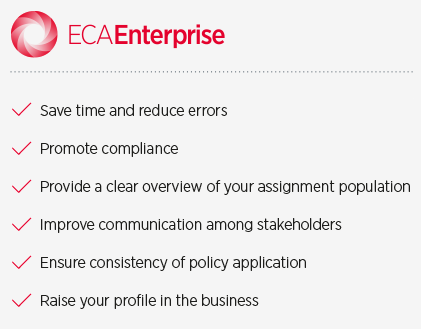Earlier this year ECA led a panel discussion on mobility technology at a conference organised by the IBIS Institute. We were lucky enough to count as panellists Cecilia Calais, Head of Global International Mobility at Ericsson and Sandra Winstanley, Manager Global Mobility & Benefits - Global HR at HEINEKEN. Together we discussed how technology is shaping the way global mobility teams work, using examples from our experience and taking advantage of audience interest and participation.
The demands and challenges faced by GM teams are consolidating technology’s position as the enabler.
”
Over the past couple of years, a lot has been said about the increased complexity that GM professionals have to deal with: a larger number of country combinations (often including challenging and less-known locations), more volatility from economic, socio-political and business perspectives, and the need to adapt existing policies and processes to a market that demands segmentation of the offering due to fast-changing employee and business requirements.
The demands and challenges faced by GM teams are consolidating technology’s position as the enabler, the differentiator that makes it possible to offer more for less, to demonstrate efficiency gains and to come to terms with ever-shortening lead times.
Of course, the expression ‘mobility technology’ is a large umbrella under which sit a variety of solutions – and like it or not, Excel spreadsheets continue to constitute the only tool available for many organisations. Amid growing concerns around poor tracking, compliance failures and lack of focus on data protection, can the right technology help implement the vision of a smarter mobility? Is ‘smarter’ mobility itself just a buzz word, or do the tools exist that can not only provide sufficiently extensive and up-to-the-minute data when it’s needed, but also allow it to be easily analysed and subsequent knowledge to be readily shared among stakeholders?
Certainly one of the most basic requirements that a strong GM technology solution should meet is improved communication among all those in the process – including third party vendors and, most importantly, assignees themselves. ‘Assignee-centric technology’ is another concept that is more than a fashionable catchphrase: at ECA, we have made it a priority. It was clear to us that clients had growing concerns about exchanging sensitive information with employees in a secure way, while at the same time they were looking to facilitate active engagement of staff in the GM process. It is up to each organisation to decide how far to push automation in assignee interaction. Approaches vary according to company core values, industry sector, generation of employees it attracts. For some assignee populations, the ideal support model would be mostly self-help based (including virtual reality to assist with relocation, or even chatbots for 24-hour communication – which prompts the question: effective tool or gimmick?). For others, they might need to be more traditional. The challenge is to balance the desire to embrace innovation and lead change against the risk of lowering the quality of interactions.
It is clear to us at ECA, from our partnerships and interactions with clients, that more widespread adoption of technology in GM management is occurring. But what technology is the best fit for each company? Cultural make-up, business priorities and types of assignment will all have an impact on that decision. Above all, we think it’s vital to think long-term and choose a partner, rather than a tool provider, that offers a flexible, future-proof solution.
We asked Ericsson and HEINEKEN for their thoughts on these issues - here is a summary of what we discussed.

Ericsson: through the experience of Cecilia Calais
Cecilia’s career is intertwined with the history and evolution of Ericsson’s mobility function. She has seen them move from filing cabinets with an index card for each assignee (she shared a vintage picture of the ‘80s filing system!) to top-of-the-range technology for mobility management.
Background
Ericsson came from a history of fluctuating assignment numbers: in response to economic conditions they would see their population reduce, and then creep – expensively! – up again. Almost 10 years ago they came to the conclusion they needed a more systematic approach to costs; by implementing ECAEnterprise not only were they able to create a culture of cost awareness across the business, but they saw many other improvements as well.
The ideal software technology needed to be modular and flexible enough to allow users to take just what was needed and mould it into a fitting, organisation-friendly shape.
”
On moving away from spreadsheets
Ditching the trusted Excel is hard! However imperfect it might be for numerous GM tasks, it is still the system we are all familiar with. For Ericsson, the turning point was the introduction of a new compensation model and an acknowledgement that they needed more transparency and sharing of accurate, detailed information across the business. They recognised that a systematic approach to package generation, supported by a tool, would be key to enhancing knowledge and awareness of the mobility function throughout the organisation, facilitating a fuller understanding of compensation issues and calculations, and providing clarity on costs. In short, Ericsson needed the evidence to meaningfully ask about every assignment: does this make sense, and can we afford it? ECAEnterprise gave them that.
One size does not fit all
The landscape of a company and its IT set-up are likely to dictate what is required from a technology solution. They will drive the choice of what to automate and what to integrate. This certainly was the case for Ericsson: process management, as an example, was already built into the way they worked, as it was linked to the existing global HR management tools. With this in mind, the ideal software technology needed to be modular and flexible enough to allow users to take just what was needed and mould it into a fitting, organisation-friendly shape. Many off-the-shelf, all-or-nothing tools cannot provide this.
On (a lot of) data
The speed and ease of generation of insightful management reporting is definitely one of the most basic attributes of a good mobility software solution. But at a time when the focus is on ensuring that every aspect of mobility management is tracked, reported on and analysed using appropriate metrics, Cecilia raised a valid point: how much is too much? What can people feasibly digest, and when does it all become rather meaningless? Finding the right balance between a comprehensive overview, which facilitates policy execution and promotes compliance, and potential overexposure is essential.
On automation
It is an absolute necessity – it becomes vital when the expectation is that the mobility team will be able to produce an offer in a matter of hours. There are, of course, potential downsides to be mindful of: it is important to prevent a disconnect between the figures and the system users, otherwise automation is not sustainable. The key is ensuring that mobility specialists can anticipate questions, defend figures, explain choices. And it goes further than this: users of software solutions need to be able to completely master its outputs, so that these become a way to educate, discuss, bring about change.

HEINEKEN: through the experience of Sandra Winstanley
Sandra is responsible for driving and executing HEINEKEN’s Global Mobility policies. She is guiding the HEINEKEN Mobility Team through a period of significant change: a fast-paced journey from archaic to innovative.
Background
Until a couple of years ago, mobility processes at HEINEKEN were still managed in a relatively old-fashioned way: to paint the picture, this involved hundreds of individual spreadsheets, little (if any) opportunity for meaningful reporting and paper-based correspondence with expats. There were thus clear areas for improvement, starting with the revision and automation of processes to achieve a clearer overview and better compliance.
On moving away from spreadsheets
Sandra described moving away from Excel as a painful but rewarding step. A word of caution though: it is likely to kickstart an irreversible process of transformation, as Sandra and HEINEKEN found, and you might discover that you had only previously seen the tip of the iceberg in terms of efficiencies you could achieve! For HEINEKEN, switching to ECAEnterprise as the data source for all expat-related information was a key step: thanks to the availability of more accurate data, and because of the time and cost savings (with mobility advisors’ time freed up to focus on more value-added activities), there are now real opportunities to bring about change. Technology makes a lot possible, and each organisation can decide how far they are willing to take it. HEINEKEN – and ECAEnterprise! – are in it for the long haul.
Moving away from Excel is a painful but rewarding step. A word of caution though: it is likely to kickstart an irreversible process of transformation, and you might discover you had only previously seen the tip of the iceberg in terms of efficiencies you could achieve!
”
On interaction with assignees
It is not just the mobility team who are benefiting from the ongoing transformation – improved communication and interaction is making everyone’s roles easier and those of assignees in particular. HEINEKEN are implementing with ECA a portal to enable assignees to securely view all assignment-related information. A pilot is underway, so watch this space!
Sandra also thinks there is room for greater use of social media in assignee interaction. It’s part of the emerging technology and HEINEKEN need to consider how best to utilise it. One obvious way would be to create expat networks; the organisation might not yet use social media (at least, not in the context of global mobility), but assignees certainly do, so it would make sense to embrace this already widely-used technology. Aside from expat networks, social media could aid keeping in touch with colleagues at home. Internal job posting is another area that could benefit from being handled less conventionally, through social media: one of the desirable effects could be an increased interest in international moves. Effectively, it could become an informal way of matching talents with opportunities.
On change management
Obtaining buy-in for new technology solutions is never easy! However, that in itself wasn’t the main obstacle encountered by Sandra and her team: a strong business case to demonstrate the value of the investment was required, of course, but after the initial approval it was a case of ensuring continued support. What presented the most challenges was change management. It was imperative to ensure that all HR users and business partners fully understood and participated in the process. And to achieve this, extensive communication and training were essential.
News since the panel discussion
As announced in our blog here, we are delighted that HEINEKEN has won the 2017 FEM EMEA EMMAs in the category "Most innovative use of technology in global mobility (Bespoke)"!
About ECAEnterprise - your one-stop global mobility management tool
ECAEnterprise, the software service chosen by many of the world's multinational companies to run their mobility programmes, is an Assignment Management System that enables mobility teams to automate the most laborious manual activities and tasks across the assignment lifecycle, at the same time promoting consistency and standardisation of approaches.
 In its core calculator product, ECAEnterprise offers flexible frameworks to create salary and costing calculations for any assignment type, with a database to easily store and revisit employees / assignment details and all calculations saved, and full visibility on assignment populations through configurable reporting.
In its core calculator product, ECAEnterprise offers flexible frameworks to create salary and costing calculations for any assignment type, with a database to easily store and revisit employees / assignment details and all calculations saved, and full visibility on assignment populations through configurable reporting.
ECAEnterprise caters for all types of requirements: it can be purchased as an off-the-shelf product or built to a company’s specification, and it is modular in its delivery, so that only the relevant functionality is selected based on actual needs.
Features of ECAEnterprise include:
- Assignment management: manage all assignment processes from initiation to completion, automation of administrative tasks, storing of assignment histories, management of employee profiles, histories and key dates
- Salaries and costings: cost, calculate, revise, review and update assignment rewards for multiple policy types and remuneration approaches
- Dynamic workflow: allow different levels of access to multiple stakeholders and to set up workflow processes to assigned owners, with target dates and dependencies
- Management reporting: create clear, configurable, attractive reports on all assignments, providing at-a-glance statistics on populations and analysis of business operations, costs, timetables and traffic lanes
- Alerts and triggers: create specific alerts and triggers to notify users when a particular trigger condition has been met (e.g. assignment coming towards its end date, work permit expiry etc.)
- Case management: create ad-hoc notes and activities related to the day-to-day management of assignments and to publish, action, delegate and complete such activities
- Document management: generate, store, access and upload key assignment related documents such as assignment contracts, customer specific forms (relocation service request, visa request and similar), assignment calculations and costings reports
- Batch processing: run mass updates of assignment packages, typically for the purposes of periodic or salary reviews
- Interfaces with third parties: pull and/or push data between systems through real-time, asynchronous WebServices; create and upload data files to/from other systems
FIND OUT MORE
Please contact us to speak to a member of our team directly.